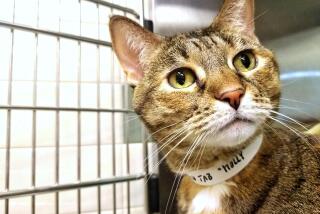Fake Fur, Real Art?
- Share via
The voice coming over the line from Wellington, New Zealand--an unmistakably Kiwi voice--crackles with mock indignation. His new book a hoax? “The very nature of hoaxes is that a hoaxer would never admit to hoaxing,” Burton Silver says. “But this book is not a hoax, of course.”
Uh-huh.
So, Burton Silver, you’re telling us that there are artists who paint cats--not pictures of cats, but using cats as the canvas--and that said cats submit to the indignity of being tarted up as a butterfly, a peacock, a giraffe, a pig, a leopard, a tartan blanket, a skeleton or Santa Claus--or just to match their owners’ home decor?
Is it just possible that the fancied-up felines in “Why Paint Cats: The Ethics of Feline Aesthetics” (Ten Speed Press) are computer-generated creations?
“We never talk about how the artwork is done,” replies Silver, adding, “I stand by everything that’s said in this book.”
Sure. And cats are born artists, too, as Silver and photographer Heather Busch showed us in an earlier collaboration, “Why Cats Paint,” their earlier book that has sold 675,000 copies.
About the new book one thing is indisputable: It is very, very funny. Now, it’s no secret that in the cats-as-artists book, Silver and Busch were spoofing art criticism. Still, Silver says, “some of the art world took it seriously and wrote reviews in a very serious way and clearly had no idea it was a parody.”
Others played along. Silver particularly delights in telling how the Sunday Times of London piled parody upon parody and “ripped into the book for not including the Renaissance period of cat art.”
Silver notes, “It’s very hard to use human artists to spoof artists and the art world. It’s crazy what’s happening. It’s art if you say it’s art, no matter what you throw out there. I could take a carrot and split it in half and put a line of toothpaste down each half and put a little spotlight on it and, provided I put [a price of] $1,500 on it, it would be regarded with some concern.”
So now, it’s the cats who are themselves getting painted. And, just as some people believed--really believed--that cats paint, there are those who believe that there are artists who really painted these cats, and for fees in the five figures.
Asked what he is spoofing this time--cat lovers, animal activists or perhaps psychiatrists?--Silver seems to be suppressing a laugh as he shoots back, “It’s not a spoof. Who said it was a spoof? Why are you people all so negative?”
His text is tongue-in-cheek scholarly, complete with footnotes and a bibliography. And there are two book cover blurbs praising the book, one from the nonexistent L.A. Art Times, whose reviewer lauded it as a celebration of “an exciting new art form,” the other from the nonexistent U.K. Cat Weekly, which found it “a work that will be truly inspiring for some and deeply disturbing for others.”
Putting to good use his degrees in psychology and sociology, he has sprinkled the text with references to obscure cultures that pioneered cat painting. He has his “artists” and “critics” spouting scholarly sounding prose about things such as transforming cat into god, observations on contemporary sexual mores, how painting cats gives us new insights into their psyches and even the palliative potential of painted cats.
The footnotes cite activist organizations including Artists for the Ethical Treatment of Animals and F.L.A.P (Free Laboratory Animals Permanently), C.R.O.K.(Cats Rule OK) and the Journal of the Embellished Cat. Vol. II. “Just because you can’t find such an organization doesn’t mean to say it’s not true,” Silver insists. The “artists,” some of whom appear quite mad, natter on in the book about “kinetic observationalism” (how painting cats with moons and stars enables them to tune into the cosmos), “neo-totemism” (the appropriation of the art of indigenous cultures to assuage imperialist guilt), “transfigurationalism” (toward a more spiritual understanding of the cat), “re-environmentalism” (imposing the image of another species onto the cat to increase our understanding of territorial prerogative) and “transmogrificationism” (confronting our prejudices by transforming the lovable cat into a less appealing species).
Asked for phone numbers for some of the artists, Silver regretted that they were unavailable. Matt Gauri, an Angeleno who became a full-time cat painter after being fired from his pet motel grooming job over a mix-up in which he painted the wrong white cat to resemble a pig, was, alas, in India, Silver said. San Francisco hairstylists Jackie and Jay Bloomfield had given up cat painting after an Arab client’s cat, on whom they’d painted Arabic slogans, was either run over or mutilated by anti-Islamists.
Likewise, the books in Silver’s selected bibliography were, well, elusive. Among these: “Simply Unfurgettable,” “The Cat as Canvas,” “Purrmutations” and “Financially Feline.”
Now, assuming that one can paint a cat, how does one go about it? Before applying peroxide and nontoxic dyes, we’re told, some artists employ pre-paint petting therapy, others swear by hypnosis and still others just kind of sneak up on the sleeping cat.
Deadpans Silver, “Fortunately, cats spend a great deal of their time asleep. I’m told that, provided you do the right pre-painting preparation exercises, where you take a damp brush and kind of brush the cat quietly while it’s asleep, it will get used to that and wake up a vivid green and wonder why it’s getting a lot of attention.”
One artist describes how he paints cats’ whiskers in a multicolor striated pattern, numbing them first by gently massaging each whisker with the pointed end of a paintbrush. Having one’s cat painted is pricey, considering that the average dye job lasts two months. But most artists offer the equivalent of root touch-ups.
In his text, Silver describes new airbrushes that use static electricity to draw the cat’s fur up in small tufts and tells about a cat owner who spent $400 to have her kitty painted like a K9 dog so as to intimidate the neighbor’s fox terrier. He also passes along one artist’s observation that cats painted with fish designs spend more time near water while those painted with birds spend more time climbing trees.
A book buyer from Seattle protested in an e-mail to Amazon.com that the book should come with a disclaimer. “Like a fool, I was taken in ... and tried to paint my cat, Mr. Pie. Needless to say, he did NOT go for it. The peroxide burned his eyes and he scratched the hell out of my arms.... What was I thinking? Paint+cats=disaster.”
But a reader in New Zealand was mesmerized by the “compliant felines,” opining that their willingness to submit to, and strut, their body art speaks volumes for their eccentricity. And more than one newspaper reviewer has bought it lock, stock and scratching post--even the bit about a New York stockbroker paying $16,000 to have an image of Charlie Chaplin painted on his cat’s bum to express his sentiments about Hollywood.
That painter cats and painted cats sprang from the brain of 57-year-old Silver is no stretch given that--and he swears this part is true--he has been a safari guide and a buffalo shooter, has taught art to aboriginal lepers, written a cartoon about a hedgehog and worked at an Indian high altitude warfare school in Kashmir.
He also invented a game called GolfCross, which is much like golf except that the balls are oval and instead of holes, there are suspended goals through which players must shoot the balls. He is also founder of the International Fringe Games, a venue he is pushing in hopes of popularizing events such as slalom running, bicycle hurdling and sprints enlivened by inserting cartwheels and handsprings. “Sport has become very unexplorative,” he explains.
Between the giggles, there is a serious message in “Why Paint Cats.” Silver says, “I think anybody would very clearly see that it is not a how-to book. It’s a why book. We want to encourage the ethical discussion of whether we should be allowed to manipulate animals in this way.” He hopes the book will initiate a broader discussion of how people treat animals, of whether they should be bred to conform to societal standards of beauty, having their tails knotted or docked or whatever, or be otherwise costumed or fancied up for our entertainment. Silver is “appalled” when someone sees the pictures and says, “I want one of these cats. Where can I get one?” He hopes people will look at the pictures and say, “Hang on--should we be doing that? Is it OK to alter the look of a cat for our own enjoyment? It’s very hard to justify that it’s for the cat’s welfare.” He can justify painting giant eyeballs on cats so as to alert birds to danger.
“Why Paint Cats” didn’t ruffle any fur at PETA, People for the Ethical Treatment of Animals. President Ingrid Newkirk thinks Silver and Busch’s work is a “just a stitch.” While suggesting that perhaps “Why Paint Cats” should come with a disclaimer, Newkirk says, “This is having fun with animals that doesn’t hurt them in the least. It’s pure whimsy, all good fun.”
Although some people may buy into it and take a fling at painting their cats, Newkirk isn’t too concerned. “You just try to hold a cat down and convert it into a porcupine. They’re not turtles, where you rub their tummies and they just go into a trance.”
More to Read
Sign up for our Book Club newsletter
Get the latest news, events and more from the Los Angeles Times Book Club, and help us get L.A. reading and talking.
You may occasionally receive promotional content from the Los Angeles Times.






